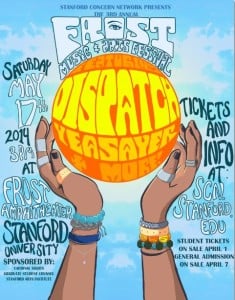
On May 17, Frost Amphitheater will host a lineup of musical artists — including Dispatch, Yeasayer and Ethan Tucker — alongside student-produced art in the third iteration of the annual Frost Music and Arts Festival.
“Dispatch is a little older and has a lot of classic hits everybody knows, and Yeasayer is a bit newer on the scene, a little more indie rock,” noted Frances Ball ’15, director of the Stanford Concert Network (SCN).
According to Ball, Frost 2014 will be larger than previous efforts in terms of both capacity and the extent to which student-made artwork is featured.
“Music is a component of art,” said Elaine Zhou ’15, one of the student liaisons between the SCN and the arts component of the festival. “You have listening but what do you do before the concert? After the concert? It’s an entire experience.”
Students who wanted to produce art for the festival in past years did so through independent study, producing works ranging from “truffula trees,” inspired by the stories of Dr. Seuss, to geodesic domes.
This year, the d.school offered “ReDesigning Theater: Interactive Art and Performance Design,” a two-quarter class in which students create interactive art that will be displayed at the festival. While this quarter focused on skills needed to execute interactive art projects, ranging from applying for grants to formal concept presentations, next quarter will focus on project execution. The class has also hosted guest speakers like Burning Man’s Crimson Rose and traveled on field trips to locations like the Exploratorium.
“It’s a real world skills class,” said course leader Michael Sturtz, who expressed hope that students would walk away from the class with what he called “creative confidence.”
“I hope that they will have the confidence to come up with an idea and incorporate all the appropriate elements to take it from its conception to its completion,” Sturtz said. “The more you are able to do that, the easier it gets. You’re able to imagine things you’ve never done before because you have the confidence to do it.”
Just as Sturtz expressed hope that the class would equip students to pursue projects beyond the classroom, Ball emphasized the festival’s potential to transcend the Stanford bubble.
“A lot of events on campus are Stanford-themed and focused on Stanford students,” she said. “This is definitely focused on students as well, but it’s a way to bring something a bit bigger to campus.”
The festival has also expanded its community reach, with one-third of this year’s tickets allotted for the general public. Ball cited UC Berkeley’s Greek Theatre, a public performance venue, as a potential model for Frost in the future.
“It’d be great if Frost were like that eventually but for now, it’s nice to bring the general public in and show them what Stanford’s all about,” Ball said.
Zhou emphasized the value, however, of ensuring that the festival retains its essence as an event students can attend to “escape and have a good time.”
“I’ve been to a few music festivals and I really like how it’s an escape,” Zhou said. “Because Stanford sometimes gets a little overwhelming, it’d be awesome to bring the same kind of vibe back here.”
Ticket for the festival will go on sale on April 1 for students and on April 8 for the general public.
Contact Madeleine Han at mhan95 “at” stanford “dot” edu.
